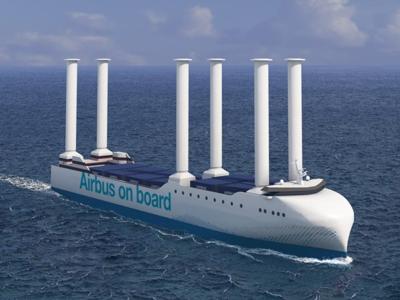Louis Dreyfus Armateurs to Build Three Ships
Airbus, the European multinational aerospace consortium comprising discrete commercial, defense and space, and helicopter divisions, is making ready to renew the fleet of chartered ocean vessels by which the company transports aircraft subassemblies between its European and U.S. assembly facilities. The ships currently utilized by the air-framer will be replaced with a trio of modern, low-emission, roll-on/roll-off vessels featuring wind-assisted propulsion.

Airbus has commissioned French merchant firm Louis Dreyfus Armateurs to build, own, and operate the three new vessels, which are slated to commence entering service in 2026. In addition to its shipbuilding interests, Louis Dreyfus owns and manages hedge funds, develops and operates telecommunications infrastructures, and controls vast tracts of real estate. Along with Archer Daniels Midland, Bunge, and Cargill, the Louis-Dreyfus Group is one of the four so-called ABCD companies by which world agriculture and commodity trading is dominated.
The vessels by which Airbus’s logistical requirements will presently be served are advertised to reduce average annual transatlantic CO2 emissions from 68,000 to 33,000 metric-tons (72,752,547-pounds) by 2030. The reduction is consistent with Airbus’s stated aim of reducing its overall industrial emissions by up to 63-percent by 2030—compared to a 2015 baseline—in keeping with the 1.5°C pathway specified in the Paris Agreement.
The fleet renewal enterprise also advances Airbus’s aspiration to increase A320 family production to 75 aircraft per-month by 2026. Each new transatlantic vessel will have the capacity to transport approximately seventy forty-foot containers and six single-aisle aircraft sub assembly sets. Individually, subject sets comprise a single inchoate aircraft’s wings, fuselage, engine pylons, and empennage. The ships currently in service are capable of accommodating only three-to-four such assemblies.
Airbus head of sustainability & environment Nicolas Chrétien stated: “The renewal of our marine fleet is a major step forward in reducing our environmental impact. The latest generation of vessels proposed by Louis Dreyfus Armateurs are more fuel-efficient than their predecessors, using cutting-edge technologies like wind-assisted propulsion. This demonstrates our determination to lead the way in decarbonizing our sector by innovating not just in aviation, but across all our industrial operations.”

Louis Dreyfus Armateurs president Edouard Louis-Dreyfus set forth: “We are very pleased to have been selected by Airbus to develop this state-of-the-art and low-emission fleet and to continue our longstanding partnership. This new project, setting high targets, reflects our ambition regarding the decarbonization of the shipping industry. We are proud to support our customers in their energy transition, going even beyond their expectations by offering innovative solutions and sustainably driving change.”
Airbus will gradually replace the chartered vessels by which its aircraft subassemblies are currently conveyed between Saint-Nazaire, France, and the plane-maker’s single-aisle aircraft final-assembly line in Mobile, Alabama.
Each of the three new vessels will be powered by a combination of six Flettner rotors—large, rotating cylinders that interact with prevailing winds to generate lift/thrust—and a pair of dual-fuel engines running on maritime diesel oil and e-methanol. The vessels’ oceanic crossings will be rendered optimally-efficient by dint of advanced routing software which seek out favorable winds and seas.
 ANN's Daily Aero-Term (05.17.24): Very High Frequency
ANN's Daily Aero-Term (05.17.24): Very High Frequency ANN's Daily Aero-Linx (05.17.24)
ANN's Daily Aero-Linx (05.17.24) ANN FAQ: Submit a News Story!
ANN FAQ: Submit a News Story! Classic Aero-TV: ANN Visits Wings Over The Rockies Exploration Of Flight
Classic Aero-TV: ANN Visits Wings Over The Rockies Exploration Of Flight Airborne Affordable Flyers 05.16.24: PRA Runway, Wag-Aero Sold, Young Eagles
Airborne Affordable Flyers 05.16.24: PRA Runway, Wag-Aero Sold, Young Eagles




